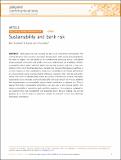Files in this item
Sustainability and bank risk
Item metadata
| dc.contributor.author | Scholtens, Lambertus Johannes Regnerus | |
| dc.contributor.author | Van 't Klooster, Sophie | |
| dc.date.accessioned | 2019-09-13T15:30:02Z | |
| dc.date.available | 2019-09-13T15:30:02Z | |
| dc.date.issued | 2019-09-10 | |
| dc.identifier | 261163551 | |
| dc.identifier | 898b6a6e-8b90-4a87-8c74-c45471cec0c4 | |
| dc.identifier | 85072994983 | |
| dc.identifier.citation | Scholtens , L J R & Van 't Klooster , S 2019 , ' Sustainability and bank risk ' , Palgrave Communications , vol. 5 , no. 1 , 105 , pp. 1-8 . https://doi.org/10.1057/s41599-019-0315-9 | en |
| dc.identifier.issn | 2055-1045 | |
| dc.identifier.other | ORCID: /0000-0001-5774-5191/work/69835037 | |
| dc.identifier.uri | https://hdl.handle.net/10023/18474 | |
| dc.description.abstract | Banks play a key role in society and are crucial for economic development. Existing literature finds a positive association between bank performance and sustainability, but tends to neglect the risk dimension. As human-driven processes interact with global social-ecological connectivity and exhibit cross-scale relationships, we investigate whether sustainability affects banks’ individual default risk and their systemic risk, i.e., their contribution to the risk of the financial system. As banks are financial intermediaries and there is no direct measure of their sustainability, we proxy for sustainability with banks’ performance on environmental, social, and governance attributes, especially their policies and performance. We control for relevant bank, market and country characteristics. It shows that higher sustainability scores of banks significantly associate with lower default risk. We also establish that outperformance on sustainability reduces banks’ contribution to systemic risk. Thus, it appears that banks’ sustainability performance can spill over to the financial system. This implies sustainability is material for banks and their supervisors. Accounting for sustainability can augment bank risk management and prudential policy decision making, and provide guidance as to how to finance a transition towards an economic system that effectively internalizes externalities. | |
| dc.format.extent | 8 | |
| dc.format.extent | 463394 | |
| dc.language.iso | eng | |
| dc.relation.ispartof | Palgrave Communications | en |
| dc.subject | Banking | en |
| dc.subject | Default risk | en |
| dc.subject | Systemic risk | en |
| dc.subject | Sustainability | en |
| dc.subject | Europe | en |
| dc.subject | HG Finance | en |
| dc.subject | E-DAS | en |
| dc.subject | SDG 8 - Decent Work and Economic Growth | en |
| dc.subject.lcc | HG | en |
| dc.title | Sustainability and bank risk | en |
| dc.type | Journal article | en |
| dc.contributor.institution | University of St Andrews. School of Management | en |
| dc.contributor.institution | University of St Andrews. Centre for Responsible Banking and Finance | en |
| dc.identifier.doi | https://doi.org/10.1057/s41599-019-0315-9 | |
| dc.description.status | Peer reviewed | en |
This item appears in the following Collection(s)
Items in the St Andrews Research Repository are protected by copyright, with all rights reserved, unless otherwise indicated.

